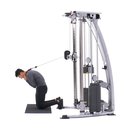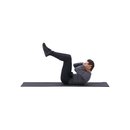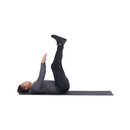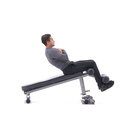Abs may not be the most challenging body part to train, but visible results can remain elusive. That's because, when all's said and done, a great workout can be undone by poor eating habits and body-fat levels more suited to a hibernating bear in winter.
Prioritizing your midsection requires not just a great workout but a commitment to eating clean and doing cardio to help get you lean. While the latter is beyond the scope of this article, we can show you the elements of how to manipulate exercises, rest periods, volume, resistance, and training frequency so that you do the right routine based on your goals and experience.
Not everyone starts from the same place, nor has the same objectives when it comes to ab training, so it would be imprudent to provide a one-size-fits-all solution. But matching your objectives with your training can help you more readily achieve your goals. That's where we can help. Below are a half-dozen ab workouts that can help you attack weak points, etch in deep ridges, and improve your core power no matter your training level.
All About Abs
First, a little abdominal science. Although you can't isolate any single area of the midsection, certain exercises allow you to emphasize one area over another.
- When you stabilize your legs, as when doing kneeling rope crunches with a cable, the upper portion of the rectus abdominis (upper abs) receives greater activation.
- When you stabilize your upper body, as when doing hanging knee raises, the lower portion of the rectus abdominis (lower abs) undergoes a greater degree of shortening.
- Besides assisting in trunk flexion, the internal and external obliques are called into play for twisting or rotational movements.
- Some exercises can work multiple areas in the same movement, depending on whether your upper or lower body is stabilized. A crunch with a crossover, for example, can target both the upper abs and obliques.
Because the abs are typically working to keep your body upright all day, they have a greater degree of slow-twitch fibers than other skeletal muscle tissue. Therefore, they fatigue at a slower rate than other muscle groups with a higher percentage of fast-twitch fibers (i.e., pecs, biceps, and hamstrings). Since fast-twitch fibers are the ones most capable of growth, you'll find a muscle group like the abdominals a little more stubborn to grow. Hence the typical rep range used to target them isn't identical to what's used to train the arms, chest, or back; instead, a slightly higher rep target may be required when training abs. Experiment. Until you determine what works best for you, use multiple rep targets (moderate to high) to elicit growth in each of the various fiber types.
Finally, don't forget about progressive overload when it comes to ab training. Simply doing three sets of 20 reps every time isn't enough; you've got to make each workout a little bit harder than the last. Strive for an extra rep or two each set, add a plate to the stack at your next workout, or slightly reduce the rest period between sets. You'll grow faster if you keep challenging yourself from workout to workout.
Remember, there are literally hundreds of ab exercises and each has a number of variations, so use these routines as a starting place. Use our Exercise Database to make exercise substitutions or create new combinations to continually make your abs work harder. This will encourage them to grow and become stronger.
No matter your experience, start here with the routine based on your goals and ability. Just make sure you don't stick to any single routine for more than about two months. Otherwise your abs will stop responding.
1. Workout For Size
Low body fat may help your waistline appear lean, but that doesn't mean your abs have the peaks and valleys to make your midsection pop. Here's a routine that uses added resistance beyond your body weight to signal muscle growth, helping transform a merely flat or underdeveloped washboard into a three-dimensional, topographical six-pack. The workout is also balanced between the three key areas of the midsection—the upper abs, lower abs, and the obliques—to ensure top-to-bottom, side-to-side development.
To thicken up the bricks of the rectus abdominis (six-pack), you'll choose a resistance so that you reach muscle failure at a fairly low rep target, about 8-12. This relatively heavier weight is superior for building muscle compared to high-rep bodyweight exercises. Similarly, if you want to build thicker obliques, continue to use a fairly low rep target. Many lifters aren't looking to build a blockier midsection, so they instead choose slightly lighter weights on oblique movements.
Moderate-rep exercises are combined with higher-rep moves to ensure that all the fibers are worked completely. Start with the most difficult exercises and progress to easier ones as your midsection fatigues. Most people find that lower-ab exercises are slightly more difficult, so start there. Though the rectus abdominis is a single muscle, you can put more emphasis on the lower region by securing your upper body and bringing your hips and pelvis toward your ribcage. Conversely, keeping your lower body anchored and curling your upper torso toward your hips works the upper abs more strongly.
Building and strengthening your abs won't necessarily make them more visible if you neglect stripping away body fat through diet and cardio. You'll need to work on these elements as well, getting as lean as possible, to really make your six-pack pop.
Notes
- On low-rep sets, use a deliberate motion and focus on an intense contraction rather than trying to speed your way through the set.
- Choose a weight in which you reach muscle failure by the target rep listed. Some movements might require you to make a change in positioning rather than simply changing the weight (for example, bending your knees on hanging leg raises) to decrease the degree of difficulty if you can't reach the target number of reps.
- When possible take the last set of each exercise past muscle failure by including dropsets, rest-pause, or partial reps—techniques that allow you to extend a set to increase the muscle burn.
- Do this workout three times a week with at least 48 hours between workouts for 6-8 weeks.

2. Routine To Get Ripped
If your goal is to get lean, obviously diet and cardio play increasingly important roles in your ultimate success. But you can tailor your workout such that it helps you chisel your middle using bodyweight movements for slightly higher rep targets.
You can do more work in less time—and really increase the muscle burn—by adding supersets, which link back-to-back exercises so that you rest only after completing both moves. Striving to progressively reduce rest intervals will also, over time, increase the intensity, making your midsection work harder, and ultimately burn more calories.
Notes
- Do all movements to muscle failure, but you may need to adjust the degree of difficulty up or down (for example, by bending your knees on hanging leg raises if it's too difficult) depending on how many reps you completed. Substitute easier or more difficult variations so that you're training within the target rep range.
- Superset the pairs of exercises noted, resting only after you complete both moves.
- Strive to work slightly harder each workout be doing a few more reps, slightly increasing the level of difficulty, or reducing between-sets rest time.
- Train for the burn rather than simply a rep target. Because you're not looking increase work )and burn more calories) with this routine rather than build muscle, this workout can be done as often as every day.
3. Beginner's Workout
This low-intensity workout consists of a lower-ab move, an upper-ab move, and a combination move to hit the major areas of the midsection. While it's light on volume and intensity, it should be used as a starting point from which to build.
Notes
- Do the exercises in order almost to the point of muscle failure. If you can do more than about 15 reps, find slight variations to increase the degree of difficulty of each move.
- As you get stronger, it's important to continue increasing the overload (greater resistance or more reps) so that you continue making progress. You should feel muscle soreness a day or two afterward, so do this workout every other day.
- In addition to increasing the overload, you'll also continue to make progress over time by increasing the volume. After four weeks, add another set to each movement, add another exercise to the mix to increase the training volume, or do both.
- Don't just speed through your reps; do them slowly and deliberately, squeezing your abdominal muscles hard during every flexing motion.

4. Emphasis on Upper Abs
As previously noted, you can put together exercises that selectively emphasize the upper abs (that is, the upper portion of the rectus abdominis shortens to a greater degree than the lower end). Though you certainly wouldn't want to focus every workout on the six-pack muscles, you can achieve greater intensity by occasionally focusing on a few particular exercises that thoroughly target it. You can also rotate routines that focus on each of the areas, or work to bring up your lagging upper abs by following this kind of workout for about 4-6 weeks.
Notes
- Start with the most difficult movement first, then choose slightly easier movements as you fatigue. Adjust bodyweight exercises as needed if the ones listed are too easy or too difficult.
- This workout employs several rep ranges so that you work with different relative intensities. Start out at a lower rep range and progress to higher reps over the course of your workout.
- Choose a weight in which you reach muscle failure by the target rep listed. Take the last set of each exercise past muscle failure by including dropsets, rest-pause, partial reps, or another technique that increases the muscle burn.
- Again, strive to continuously increase the overload from one workout to the next, whether it's by doing an extra rep or two, or by choosing slightly more difficult variations of a movement.
5. Emphasis on Lower Abs
As stated, this can be rotated with the upper-ab workout, or you could focus on your lower abs for 4-6 weeks to help bring them up. If your lower abs are particularly lagging, you might also consider staggering the workouts so you do this lower-ab routine two times for every upper-ab routine. You can also emphasize lower abs in the basic mass routine by switching out exercises.
Notes
- Start with the most difficult movement first, then choose slightly easier movements as you fatigue. Adjust bodyweight exercises as needed if the ones listed are too easy or too difficult.
- This workout employs several rep ranges so that you work with different relative intensities. Start out at a lower rep range and progress to higher reps over the course of your workout.
- Choose a weight in which you reach muscle failure by the target rep listed (or use a heavier or lighter medicine ball). Take the last set of each exercise past muscle failure by including dropsets, rest-pause, partial reps, or another technique that increases the muscle burn.
- Endeavor to continuously increase the overload from one workout to the next, whether it's by doing an extra rep or two, or by choosing slightly more difficult variations of a movement.
6. Emphasis on Obliques
While the rectus abdominis is the visible six-pack that's involved in flexion of the lumbar spine, it's not the only midsection muscle. The fibers of the external obliques run diagonally and sit atop the internal obliques. They're involved in trunk flexion movements in addition to the rectus abdominis, as well as rotation, twisting, and crunching out to your sides in the lateral plane.
Oftentimes bodybuilders opt for slightly higher reps (with less resistance) when training obliques in a conscious effort to avoid thickening the sides of the waist. Oblique exercises can also be inserted into upper- or lower-ab workouts or done on a separate day as shown here. A number of bodyweight moves (like the air bike) work more than one area simultaneously.
Notes
- Start with the most challenging movement first, then progress through slightly easier exercises as you fatigue. Adjust bodyweight exercises as needed if the ones listed are too easy or too difficult.
- This workout employs several rep ranges so that you're working with different relative intensities. Start out at a lower rep range and progress to higher reps over the course of your workout.
- Choose a weight in which you reach muscle failure by the target rep listed or go for the time in seconds. Take the last set of each exercise past muscle failure by including dropsets, rest-pause, partial reps, or another technique that increases the muscle burn.
- Continuously increase the overload from one workout to the next, whether it's by doing an extra rep or two, or by choosing slightly more difficult variations of a movement.













































